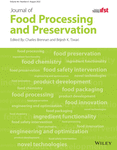Quality changes and experimental accelerated shelf-life determination of ready-to-eat burgers made from striped catfish and salmon mince blend by thermal processing in retort pouches
Abstract
Ready-to-eat (RTE) fish burgers were developed from minced striped catfish (Pangasius hypophthalmus) and salmon (Salmo salar) mixed at the ratios of 100:0, 75:25, 50:50, 25:75, and 0:100 by thermal processing in flexible pouches using a water spray retort at a temperature of 121.1°C for 15 min. The RTE fish burgers were stored at temperatures of 25, 35, and 45°C for 3 months. It was found that the diameter, weight, L* value, and cohesiveness of the RTE fish burgers decreased, whereas the a* and b* values, hardness, chewiness, and thiobarbituric acid (TBA) values of the RTE fish burger increased with longer storage time and higher storage temperatures. Total viable count, yeast and mold, and Clostridium perfringens were below 10 CFU/g (detection limit) and coliform was below 3 MPN/g during 3-month storage. The shelf-life prediction of the RTE fish burgers using the Accelerated Shelf-life Test (ASLT) was conducted. The times of product decay were assessed at 3.92 and 1.40 months at the storage temperatures of 35 and 45°C, respectively. The TBA value was used as the shelf-life index of the RTE fish burgers. The calculated shelf-life of the RTE fish burgers stored at 20 and 25°C using the Q10 technique were 13.1 and 7.8 months, respectively.
Novelty impact statement
The aim of this study is to formulate ready-to-eat fish burgers made from striped catfish and salmon mince blend. Thermal treatment can lead to lipid oxidation, which limits the shelf life of the products. The predicted shelf life of the burgers determined based on TBA value was approximately 13.1 and 7.8 months at 20 and 25°C, respectively, or longer with less salmon content.
CONFLICT OF INTEREST
The authors report no conflict of interest. The authors alone are responsible for the content and writing of the paper.
Open Research
DATA AVAILABILITY STATEMENT
The data that support the findings of this study are available from the corresponding author upon reasonable request.




